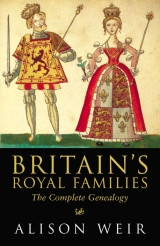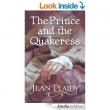
Текст книги "Britain's Royal Families"
Автор книги: Элисон Уир
Жанр:
Историческая проза
сообщить о нарушении
Текущая страница: 14 (всего у книги 21 страниц)
James V married secondly, by proxy in May, 1538, and in person on 12 June, 1538, at St Andrews Cathedral, Fife:
Mary
She was the daughter of Claude I, Duke of Guise-Lorraine, by Antoinette, daughter of Francis de Bourbon, Duke of Vendôme, and she was born on 22 November, 1515, at Bar-le-Duc, France. She married firstly Louis II, Duke of Longueville ( d.1537), on 4 August, 1534, and had issue:
1 Francis, Duke of Longueville (1535–1551).
2 Louis ( b. &d.1537).
Mary was crowned Queen Consort on 22 February, 1540, at Holyrood Abbey, Edinburgh. She died on 11 June, 1560, at Edinburgh Castle, and was buried in Rheims Cathedral, France.
Issue of marriage:
1 James
He was born on 22 May, 1540, at St Andrews, Fife, and was Duke of Rothesay from birth. He died in April, 1541, at St Andrews, and was buried in Holyrood Abbey, Edinburgh.
2 Arthur or Robert
He was born in April, 1541, at Falkland Palace, Fife, where he died, aged 8 days, the same month. He was styled Duke of Albany during his lifetime. He was buried in Holyrood Abbey, Edinburgh.
3 Queen Mary(  see here).
see here).
James V also had the following illegitimate issue:
By Elizabeth or Katherine, daughter of Sir John Carmichael:
1 John, Prior of Coldingham (1531/2–1563); he married Jean, daughter of Patrick Hepburn, 3rd Earl of Bothwell, and had issue.
By Margaret, daughter of John, 4th Lord Erskine:
2 James Stewart, Earl of Moray and Mar (1531?–murdered 1570); he married Agnes, daughter of William Keith, 3rd Earl Marischal, and had issue.
By Euphemia, daughter of Alexander, 1st Lord Elphinstone:
3 Robert, Earl of Orkney and Prior of Holyrood (1533–1591); he married Janet ( d.1598), daughter of Gilbert Kennedy, 3rd Earl of Cassilis, and had issue.
By Elizabeth Shaw of Sauchie:
4 James Stewart, Abbot of Kelso and Melrose (1529?–1557).
By Christine Barclay:
5 James Stewart.
By Elizabeth, daughter of John Stewart, 3rd Earl of Lennox:
6 Adam, Prior of the Charterhouse ( d.1606); he married Janet, daughter of William Ruthven.
By Elizabeth Bethune or Beaton:
7 Jean; she married Archibald Campbell, 5th Earl of Argyll ( d.1573), from whom she was later divorced.
By unknown mothers:
8 Robert, Prior of Whithorn ( d.1581).
9 Margaret.
JAMES V
He died on 14 December, 1542, at Falkland Palace, Fife, and was buried in Holyrood Abbey, Edinburgh.
He was succeeded by his daughter Mary.

Queen Mary
FATHER: James V(  see here).
see here).
MOTHER: Mary of Guise(  see here, under James V).
see here, under James V).
SIBLINGS: (  see here, under James V).
see here, under James V).
QUEEN MARY
She was born on 8 December, 1542, at Linlithgow Palace. She succeeded her father as Queen of Scotland on 14 December, 1542, and was crowned on 9 September, 1543, at Stirling Castle. She became Queen Consort of France on 6 July, 1559, upon the accession of her first husband to the French throne.
Queen Mary married firstly, on 24 April, 1558, at the Cathedral of Notre Dame, Paris:
Francis II
He was the son of Henry II, King of France, by Catherine, daughter of Lorenzo de’ Medici, Duke of Florence, and he was born on 16 January, 1544, at the Château of Fontainbleau-sur-Loire, France. He became King Consort of Scotland upon his marriage to Queen Mary. He succeeded his father as King of France on 6 July, 1559, and was crowned on 18 September, 1559, at Rheims Cathedral. He died on 5 December, 1560, at Orléans, France, and was buried in the Cathedral of St Denis, Paris. There was no issue of the marriage.
Queen Mary married secondly, on 29 July, 1565, in the Chapel of Holyrood Palace, Edinburgh:
Henry
He was the son of Matthew Stewart (who had adopted the French form of his surname, Stuart), 4th Earl of Lennox, by Margaret, daughter of Archibald Douglas, 6th Earl of Angus, by Margaret Tudor, daughter of Henry VII of England and widow of James IV. He was born on 7 December, 1546, at Temple Newsham, Yorkshire, and was styled Lord Darnley from birth. He was created Baron Ardmannoch and Earl of Ross on 15 May, 1565, and Duke of Albany on 20 July. He was proclaimed King of Scotland on 28 July, 1565. He was murdered, probably suffocated or strangled before his house was blown up, on 10 February, 1567, at the old Provost’s Lodging, Kirk o’ the Field, Edinburgh, and buried in the Chapel Royal, Holyrood Palace.
Issue of marriage:
1 James VI & I(  see here).
see here).
Queen Mary married thirdly, on 15 May, 1567, at Holyrood Palace, Edinburgh:
James
He was the son of Patrick Hepburn, 3rd Earl of Bothwell, and he was born in c.1535. He succeeded his father as 4th Earl of Bothwell in September, 1556. He married firstly Jean, daughter of George Gordon, 4th Earl of Huntly, on 24 February, 1566; they were divorced on 3 May, 1567, in the Protestant Commissary Court of Edinburgh, on grounds of his adultery, the marriage was also annulled on 7 May, 1567, on grounds of consanguinity. James was created Duke of Orkney and Earl of Shetland on 12 May, 1567. His titles and estates were all declared forfeit on 20 December, 1567. He died on 14 April, 1578, in prison at Dragsholm Castle, Denmark, and was buried in Faarevejle Church, Dragsholm, Denmark.
Issue of marriage:
2 & 3 Stillborn twins
They were born between 18 and 24 July, 1568, at Lochleven Castle.
QUEEN MARY
She was forced by the lords of Scotland to abdicate in favour of her son on 24 July, 1567. She fled to England, where she was kept a prisoner for 18 years by Elizabeth I. She plotted to take the English crown, and was executed on 8 February, 1587, at Fotheringhay Castle, Northants. She was buried in Peterborough Cathedral; her remains were removed to Westminster Abbey in 1612.
She was succeeded by her son James.

James VI
FATHER: Henry Stuart, Lord Darnley(  see here, under Queen Mary).
see here, under Queen Mary).
MOTHER: Mary, Queen of Scots(  see here).
see here).
SIBLINGS: James VI did not have any siblings.
JAMES VI
Christened Charles James, he was born on 19 June, 1566, at Edinburgh Castle, and was Duke of Rothesay from birth. He succeeded his father as Duke of Albany, Earl of Ross and Baron Ardmannoch on 10 February, 1567. He succeeded his mother as King of Scotland on 24 July, 1567, and was crowned on 29 July, 1567, at the Church of the Holy Rude, Stirling.
JAMES VI
He succeeded Elizabeth I, last of the Tudor sovereigns, as King of England, on 24 March, 1603, thus founding the Royal House of Stuart (now using the French version of the name) and uniting for the first time the Crowns of England and Scotland under one monarch. Henceforth, the kingdom incorporating England and Scotland would be known as Great Britain.
For further details of the life of James VI and I,  under James I.
under James I.
CHAPTER SEVEN
The House of Stuart
England and Scotland became one united kingdom in 1603 when James VI of Scotland became James I of England, and thus finally fulfilled Edward I’s dream of the two countries being joined together.
The Stuart century was to see dramatic changes in the nature of the monarchy. James I believed in the Divine Right of Kings, a doctrine which held that the King was God’s mouthpiece on earth, and could do and say no wrong. This was a view also held by James’s son, Charles I, who, when thwarted by Parliament – a Parliament grown used to being consulted to an increasingly greater degree by successive Tudor monarchs – tried to rule without it. He failed, and the country was plunged into a great civil war, which ended with the King’s execution and the declaration of a Republic or ‘Commonwealth’ under Oliver Cromwell, who became Lord Protector.
Against the odds, the monarchy did survive. Charles II lived in exile at the courts of Holland and France while Cromwell governed, but the Lord Protector’s hold on the country died with him in 1658. His son Richard was weak and ineffectual, and it was not long before Parliament sent for Charles II, whose Restoration took place in May, 1660. Yet by then, the balance of power had been tipped firmly on the side of Parliament, and no British monarch after that date would ever enjoy the autonomy exercised by his predecessors. In fact, it was in the late 17th century that ‘constitutional’ monarchy came into being in Britain; this meant that, instead of actually ruling the country, the sovereign reigned over it. The real power lay with an elected Parliament. In 1688, James II, a professed Catholic, realised that he could not hold the throne in the face of Protestant opposition, and fled the country. Parliament deemed that this act was tantamount to abdication, and invited William of Orange, husband of James’s daughter Mary, to take the throne of Britain with his wife. In what was known as the ‘Bloodless’ or ‘Glorious’ Revolution, he accepted, and thus became the first ‘constitutional’ monarch.
The unpopularity of James II, mainly due to his Catholicism, made King and Parliament realise that never again could Britain be successfully ruled by a monarch not of the Protestant faith of the Church of England. Thus, in 1701 was passed the Act of Settlement, barring any Roman Catholic from ascending the throne, and any British sovereign from marrying a Roman Catholic. This same Act also settled the succession, in default of Stuart heirs, upon the successors of Sophia of Bohemia, a granddaughter of James I, who had married the Protestant Ernest Augustus, Elector of Hanover, in Germany.
The Stuarts, like the Tudors, were not dynastically robust. Many of their children died young or were miscarried – poor Queen Anne suffering the most losses in this respect – and those who did grow to maturity died in the flower of youth of smallpox. Charles II’s wife was barren, so was Mary II. Anne’s children had all died by the time she ascended the throne. James II’s only surviving son was rumoured, falsely, to have been a changeling, and spent his life in exile, plotting to regain the throne from which he, a Catholic, was debarred by the Act of Settlement. Therefore, when Queen Anne died in 1714, there was no suitable heir of the House of Stuart to succeed her. Thus it came about that Prince George, Elector of Hanover, a bucolic German who could speak no English, succeeded to the throne of Britain and founded the Hanoverian dynasty.

James I
JAMES I
He succeeded Elizabeth I as King of England on 24 March, 1603, thus founding the Royal House of Stuart and uniting the crowns of England and Scotland under one monarch. (For details of his earlier life,  see here, under James VI of Scotland in the previous chapter.) James was crowned on 25 July, 1603, in Westminster Abbey.
see here, under James VI of Scotland in the previous chapter.) James was crowned on 25 July, 1603, in Westminster Abbey.
James VI & I married, by proxy on 20 or 24 August, 1589, at Kronborg Castle, Copenhagen, Denmark, and in person on 23 November, 1589, at Oslo, Norway, and again in person on 21 January, 1590, at Kronborg Castle:
Anne
She was the daughter of Frederick II, King of Denmark and Norway, by Sophia, daughter of Ulrich III, Duke of Mecklenburg-Güstrow. She was born on 14 October (date on coffin plate) (although the date is sometimes incorrectly given as 12 December), 1574, at Skanderborg Castle, Jutland, Denmark. She was crowned Queen Consort of Scotland on 17 May, 1590, at Holyrood Abbey, Edinburgh, and Queen Consort of England on 25 July, 1603, in Westminster Abbey. She died on 4 March (date on coffin plate) (although other sources state 1 or 12 March), 1619, at Hampton Court Palace, and was buried in Westminster Abbey.
Issue of marriage:
1 Henry Frederick
He was born on 19 February, 1594, at Stirling Castle, and was Duke of Rothesay, Earl of Carrick, and Lord of the Isles from birth. He became Duke of Cornwall upon the accession of his father to the throne of England on 24 March, 1603. He was made a Knight of the Garter on 14 June, 1603. He was created, and invested as, Prince of Wales and Earl of Chester on 4 June, 1610, at Westminster Abbey. He died on 6 (or, less probably, 12 or 16) November, 1612, at St James’s Palace, London, of typhoid, and was buried in Westminster Abbey.
2 Stillborn child
It was born at the end of July, 1595.
3 Elizabeth
She was born on 19 August, 1596, at Dunfermline Palace, Fife. She married Frederick Henry of Wittelsbach, Elector Palatine of the Rhine and later Frederick V, King of Bohemia (1596–1632), on 14 February, 1613, at the Chapel Royal, Whitehall Palace, London, and had issue:
1
Frederick Henry (1614–drowned 1629).
2
Charles Louis, Duke of Bavaria, Elector Palatine of the Rhine (1618–1680); he married firstly Charlotte (1627–1687), daughter of William V, Landgrave of Hesse-Cassel, and had issue, although they were later divorced. He married secondly, morganatically, Marie Susanne Louise (1634–1677), Raugräfin of Degenfeld, daughter of Baron Martin Christopher von Degenfeld, and had issue.
3
Elizabeth, Abbess of Hervorden (or Herford) (1618–1680).
4
Rupert, Duke of Cumberland (1619–1682); he married, morganatically, Frances Baird (
d.
1708). He also had illegitimate issue.
5
Maurice (1621–drowned 1654).
6
Louise Hollandine, Abbess of Maubisson, Pontoise (1622–1709).
7
Louis (1623–1624).
8
Edward (1625–1663); he married Anne (1616–1684), daughter of Charles I de Gonzaga, Duke of Nevers and Mantua, and had issue.
9
Henrietta Maria (1626–1651); she married Sigismund Ragotski, Prince of Siebenbürgen, Transylvania (1623?–1652).
10
John Philip Frederick (1627–killed 1650).
11
Charlotte (1628–1631).
12
Sophia; she married Ernest Augustus, Elector of Hanover, and became the mother of George I (

see here
, under George I).
13
Gustavus Adolphus (1632–1641).
Elizabeth became Queen Consort of Bohemia upon the accession of her husband to the throne of Bohemia on 27 August, 1619, and was crowned as such on 7 November, 1619, at Prague Cathedral, Bohemia. She was driven into exile with her husband in 1620 after he was deposed, and was afterwards known as ‘the Winter Queen’. There is no foundation in the rumour that, after Frederick’s death, she married secondly William Craven, Earl of Craven. She died on 3, 12, 14 or 23 February, 1662, at Leicester House, Leicester Fields, London, and was buried in Westminster Abbey.
4 Margaret
She was born on 24 December, 1598, at Dalkeith Palace, Scotland, and died in March, 1600, at Linlithgow Palace, Fife. She was buried in Holyrood Abbey, Edinburgh.
5 Charles I(  see here).
see here).
6 Robert Bruce
He was born on 18 January or 18 February, 1602, at Dunfermline Palace, Fife. He was designated Duke of Kintyre and Lorne, Marquess of Wigtown, Earl of Carrick and Lord of Annerdail (Annandale?) on 2 May, 1602. He died on 27 May, 1602, at Dunfermline Palace, Fife, and was buried in Dunfermline Abbey.
7 Stillborn son
He was born in May, 1603, at Stirling Castle.
8 Mary
She was born on 8 April, 1605, at Greenwich Palace, Kent, She died on 16 September or 16 December, 1607, at Stanwell Park, Staines, Middlesex, and was buried in Westminster Abbey.
9 Sophia
She was born on 22 June, 1606, at Greenwich Palace, Kent, and died there on 23 June, 1606. She was buried in Westminster Abbey.
Queen Anne also suffered at least three other miscarriages.
JAMES I & VI
He died on 27 March, 1625, at Theobalds Park, Herts., and was buried in Westminster Abbey.
He was succeeded by his son Charles.

Charles I
FATHER: James I(  see here).
see here).
MOTHER: Anne of Denmark(  see here, under James I).
see here, under James I).
SIBLINGS: (  see here, under James I).
see here, under James I).
CHARLES I
He was born on 19 November, 1600, at Dunfermline Palace, Fife. He was created Duke of Albany, Marquess of Ormonde, Earl of Ross and Baron of Ardmannoch on 23 December, 1600. He was created Duke of York and made a Knight of the Bath on 6 January, 1605. He was made a Knight of the Garter on 24 April, 1611. He succeeded his brother Henry as Duke of Cornwall and Rothesay on 6 November, 1612, and was created and invested as Prince of Wales and Earl of Chester on 4 November, 1616, at Whitehall Palace, London. He succeeded his father as King of Great Britain on 27 March, 1625, and was crowned on 2 February, 1626, at Westminster Abbey. He was crowned in Scotland on 15 or 18 June, 1633, at Holyrood Abbey, Edinburgh.
Charles I married, by proxy on 1 or 11 May, 1625, at the Cathedral of Notre Dame, Paris, and in person on 13 June, 1625, at St Augustine’s Church, Canterbury, Kent:
Henrietta Maria
She was the daughter of Henry lV (of Bourbon), King of France, by Mary, daughter of Francis I de’ Medici, Grand Duke of Tuscany, and she was born on 26 November, 1609, at the Palace of the Louvre, Paris. She was not crowned Queen Consort; as a Roman Catholic, she would not allow herself to participate in the Anglican coronation ritual. She died on 21 August (O.S.) or 31 August (N.S.), 1669, at the Château of St Colombes, near Paris, and was buried in the Cathedral of St Denis, Paris.
Issue of marriage:
1 Charles James
He was born on 13 May, 1629, at Greenwich Palace, Kent, and was Duke of Cornwall and Rothesay from birth. He died the same day, and was buried in Westminster Abbey.
2 Charles II (  see here).
see here).
3 Mary Henrietta
She married William II of Orange, and became the mother of William III. (  see here, under William III).
see here, under William III).
4 James II (  see here).
see here).
5 Elizabeth
She was born on 29 December, 1635, at St James’s Palace, London. She died on 8 September, 1650, in prison at Carisbrooke Castle, Isle of Wight, and was buried in St Thomas’s Church, Newport, Isle of Wight.
6 Anne
She was born on 17 March, 1637, at St James’s Palace, London. She died on 5 November, 1640, at Richmond Palace, Surrey, of consumption, and was buried in Westminster Abbey.
7 Katherine
She was born on 29 June, 1639, at Whitehall Palace, London, and died the same day. She was probably buried in Westminster Abbey.
8 Henry
He was born on 8 July, 1640, probably at Oatlands Palace, Surrey, and was probably styled Duke of Gloucester from birth. He was made a Knight of the Garter on 4 April, 1653, and is said to have been created Duke of Gloucester and Earl of Cambridge on 13 May, 1659. He died on 13 (O.S.) or 23 (N.S.) September, 1660, at Whitehall Palace, London, and was buried in Westminster Abbey.
9 Henrietta Anne
Known as ‘Minette’, she was born on 16 June, 1644, at Bedford House, Exeter, Devon. She married Philip of Bourbon, Duke of Orléans (1640–1701), on 21 (O.S.) or 31 (N.S.) March, 1661, at the Chapel of the Palais Royale, Paris, and had issue:
1 Marie Louise (1662–1689); she married Charles II, King of Spain (1661–1700).
2 Miscarriage (1663).
3 Philip Charles, Duke of Valois (1664–1666).
4 Unnamed daughter ( b.& d.1665).
5 Miscarriage (1666).
6 Miscarriage (1667).
7 Miscarriage (1668).
8 Anne Marie (1669–1728); she married Victor Amadeus II, Duke of Savoy and King of Sardinia (1666–1732), and had issue, from whom descends the present day Stuart claimant to the throne of Great Britain (who is a Roman Catholic and therefore barred from the succession).
Henrietta Anne died on 15 or 30 June, 1670, at the Palace of St Cloud, near Paris, and was buried in the Cathedral of St Denis, Paris.
CHARLES I
He was tried and condemned to death by an illegally convened Parliament following the conclusion of the Civil War between the Cavaliers (supporters of the King) and the Roundheads (Parliamentarians), the latter being led by Oliver Cromwell. Charles I was convicted of treason against the state, and was executed on 30 January, 1649, outside Whitehall Palace, London. He was buried in St George’s Chapel, Windsor. After his death, Britain was declared a Republic (for the only time in its history) with Oliver Cromwell as Lord Protector. Charles I was succeeded in name only by his son Charles, then in exile in France.

Charles II
FATHER: Charles I(  see here).
see here).
MOTHER: Henrietta Maria of France(  see here, under Charles I).
see here, under Charles I).
SIBLINGS: (  see here, under Charles I).
see here, under Charles I).
CHARLES II
He was born on 29 May, 1630, at St James’s Palace, London, and was Duke of Cornwall and Rothesay from birth. He was made a Knight of the Garter on 21 May, 1638, and around the same time was designated Prince of Wales and Earl of Chester, although he was never formally so created. He succeeded his father as King of Great Britain in name only on 30 January, 1649; Charles I was executed on that day, and Charles II was then an exile in France, whilst Cromwell took up the reins of government in Britain under the title Lord Protector. The Scots rallied to Charles’ cause, and he was crowned on 1 January, 1651, at Scone Abbey, Perthshire. He was formally restored to the throne of Great Britain, Cromwell having died, on 29 May, 1660, and was crowned on 23 April, 1661, at Westminster Abbey.
Charles II married,on 21/22 May, 1662, at the Church of St Thomas à Becket, Portsmouth:
Katherine Henrietta
She was the daughter of John IV, Duke of Braganza and King of Portugal, by Louisa Maria, daughter of John Manuel Domingo Perez de Guzman, 8th Duke of Medina-Sidonia, and she was born on 15 (O.S.) or 25 (N.S.) November, 1638, at Vila Viçosa, Lisbon, Portugal. She was never crowned as Queen Consort because she was a Roman Catholic and could not take part in the Anglican coronation ritual. She died on 30 November or 1 December, 1705, at Belém Palace or at Bemposta Palace, Lisbon, Portugal, and was buried in the monastery of Belém, Lisbon.
Issue of marriage:
1 Miscarriage
This occurred in 1662.
2 Stillborn child
It was born in February, 1666, at Oxford.
3 Stillborn child
It was born on 7 May, 1668.
4 Stillborn child
It was born on c.7 June, 1669.
Charles II also had the following illegitimate issue:
By Margaret de Carteret of Jersey:
1 James, a Jesuit (1646–1667?).
By Lucy (1630?–1658), daughter of Richard Walter of Haverfordwest:
2 James Crofts, who took his wife’s surname of Scott upon marriage, Duke of Monmouth (1649–executed 1685); he married Anne (1651–1732), daughter of Francis Scott, Earl of Buccleuch, and had issue.
Monmouth always claimed that his parents had been married, and that he was therefore legitimate; he also claimed to possess their marriage lines, but never produced them.
Lucy Walter bore another child, Mary, but Charles II was not her father.
By Elizabeth, afterwards Lady Shannon, daughter of Sir Robert Killigrew:
3 Charlotte Jemima Henrietta Maria FitzRoy (1650–1684); she married firstly James Howard, Earl of Suffolk ( d.1669). She married secondly William Paston, 2nd Earl of Yarmouth (1653–1732), and had issue.
By Katherine, daughter of Thomas Pegge of Yeldersley, Derbyshire:
4 Charles FitzCharles, Earl of Plymouth (1657–1680); he married Bridget ( d.1718), daughter of Thomas Osborne, 1st Duke of Leeds.
5 Katherine (1658–1759); she was a nun at Dunkirk, France.
6 Unnamed daughter (?) (Katherine?); her existence is conjectural. She is said to have died young.
By Barbara (1641–1709), daughter of William Villiers, 2nd Viscount Grandison, and wife of Roger Palmer, Earl of Castlemaine; she was later created Duchess of Cleveland in her own right:
7 Anne FitzRoy (1661–1722); she married Thomas Lennard, Earl of Sussex (1654–1715). She was possibly the daughter of Roger Palmer, although the King acknowledged her as his own.
8 Charles FitzRoy, Duke of Southampton and Cleveland (1662–1730); he married firstly Mary (1664–1680), daughter of Sir Henry Wood. He married secondly Anne (1663–1745), daughter of Sir William Poultney of Misterton, Leics., and had issue.
9 Henry FitzRoy, Duke of Grafton (1663–1690); he married Isabella ( d.1723), daughter of Henry Bennett, 1st Earl of Arlington, and had issue.
10 Charlotte FitzRoy (1664–1717); she married Edward Henry Lee, Earl of Lichfield (1663–1716), and had issue.
11 George FitzRoy, Duke of Northumberland (1665–1716); he married firstly Katherine ( d.1714), daughter of Robert Wheatley of Bracknell, Berks., and secondly Mary ( d.1738), daughter of Henry Dutton.
12 Barbara (who later assumed the name Benedicte when she entered the religious life) Prioress of Hôtel Dieu, Pontoise, France (1672–1737). She had illegitimate issue. Although Lady Castlemaine claimed that Charles II was Barbara’s father, other evidence makes it more probable that she was the daughter of John Churchill, 1st Duke of Marlborough.
By Eleanor, known as ‘Nell’ (1650–1687), daughter of Thomas Gwyn or Gwynne:
13 Charles Beauclerk, Duke of St Albans (1670–1726); he married Diana ( d.1742), daughter of Aubrey de Vere, 20th Earl of Oxford, and had issue.
14 James, Lord Beauclerk (1671–1680).
By Louise Renée de Penencoët de Quérouialle (or Kérouaille), Duchess of Portsmouth in her own right (1649–1734):
15 Charles Lennox, Duke of Richmond, and Duke of Aubigny in France (1672–1723); he married Anne, daughter of Francis, Lord Brudenell, and had issue.
By Mary, or ‘Moll’, Davies, an actress:
16 Mary Tudor (1673–1726); she married firstly Edward Ratcliffe, 2nd Earl of Derwentwater (1655–1705), and had issue. She married secondly Henry Graham of Levens ( d.1707), and thirdly James Rooke.
CHARLES II
He died on 6 February, 1685, at Whitehall Palace, London, of the effects of a stroke, and was buried in Westminster Abbey.
He was succeeded by his brother James.








